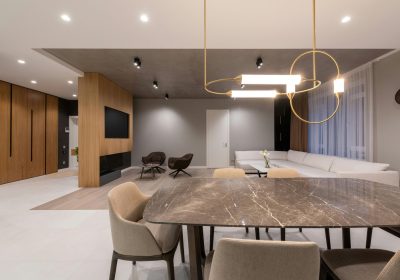Ground Floor Extensions in Queensland: A Complete Homeowner’s Guide
Australia’s housing market has remained tight for years. High purchase prices, stamp duty and the emotional toll of relocating mean many homeowners prefer to improve what they already own rather than buy something bigger. Recent data shows that more than 30 % of home improvement projects in New South Wales and Victoria involve extensions. Ground‑floor extensions—expanding horizontally rather than vertically—are among the most popular and versatile ways to add space for living, working or entertaining. Families build new rooms to accommodate growing children, convert garages into studios or add light‑filled rear extensions that connect seamlessly with gardens. Extending at ground level also avoids the structural complexities and stair access issues that come with second‑storey additions.
This comprehensive ebook explores every aspect of ground‑floor extensions in Australia. It guides readers from early planning through design, approvals, construction and project management. It explains costs and regulations, offers tips for finding the right professionals, and showcases real‑world examples from leading builder Ward Builders. Whether you are considering a modest living‑room add‑on or a substantial multi‑room project, this guide will help you make informed decisions and achieve a seamless addition that enhances your home’s value and livability.
1 Understanding Ground‑Floor Extensions
1.1 What Is a Ground‑Floor Extension?
A ground‑floor extension involves expanding the footprint of an existing single dwelling at the same level. Unlike second‑storey additions, it spreads outward to create more habitable space—often new living areas, kitchens, bedrooms, studios or granny flats. These projects may involve:
- Rear extensions. Popular for connecting interiors to gardens and adding open‑plan kitchen/dining areas.
- Side extensions. Used to widen kitchens or bathrooms in narrow terraces or semidetached houses and may require negotiation with neighbours.
- Wrap‑around extensions. Combining rear and side additions to create generous L‑shaped spaces.
- Granny flats/secondary dwellings. Attached or detached dwellings used for rental income, multi‑generational living or teenage retreats.
- Garage conversions. Low‑cost transformations of garages into studios or bedrooms; these projects still require insulation, flooring and compliance upgrades.
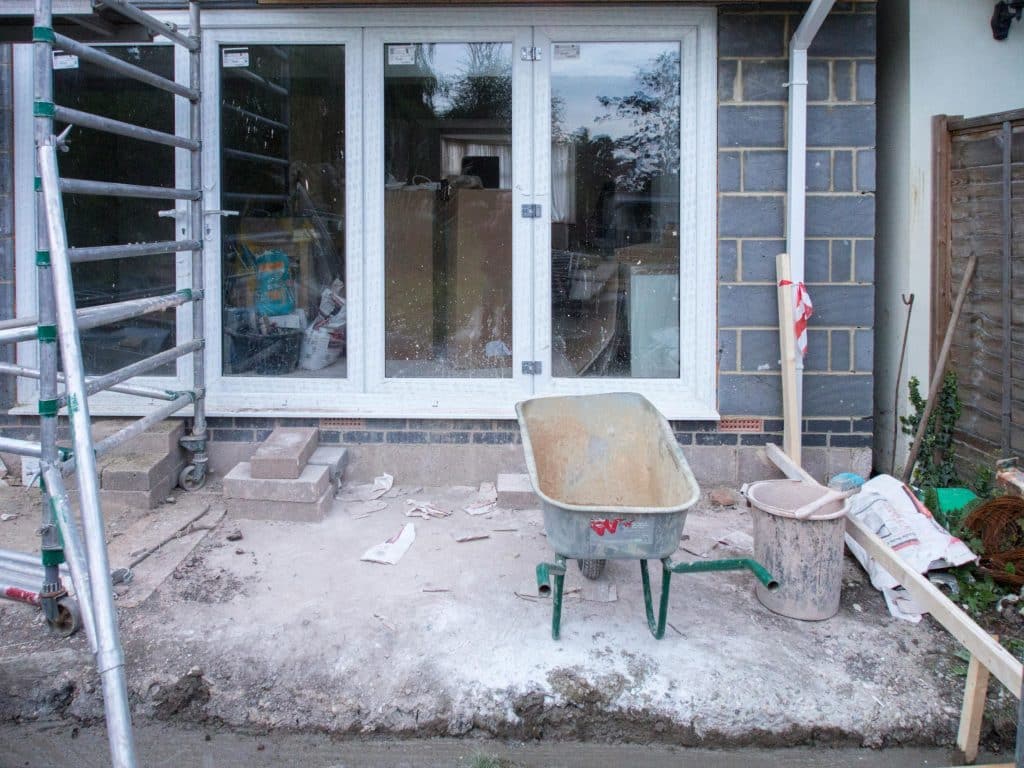
1.2 Why Choose a Ground‑Floor Extension?
- Lifestyle flexibility. A well‑planned extension solves real lifestyle problems: providing extra bedrooms, a home office, better storage or open‑plan living. You can stay in your community, keep children in the same school and avoid moving costs like stamp duty and agent fees.
- Improved accessibility. Ground‑floor extensions eliminate the need for stairs, benefiting families with young children, older residents or people with mobility issues.
- Indoor–outdoor connection. Extending toward the garden allows for expansive living areas that flow into outdoor patios or decks. This integration is a hallmark of contemporary Australian design.
- Cost efficiency. Building horizontally is often cheaper per square metre than going up because it avoids reinforcing existing foundations and adding staircases. According to Archicentre Australia, extensions can cost between $1,900 and $3,600 per m², while a general Australian average of $2,000 – $4,000 per m² is common for ground‑floor additions. Rear add‑ons of around 20 m² typically cost $60,000 – $90,000.
- Seamless design. With thoughtful planning, ground‑floor additions can blend with the existing home’s roofline, materials and window styles to enhance resale value.
1.3 Ground Floor vs. Second‑Storey Extensions
Deciding between expanding outward or upward depends on needs, site characteristics and budget. Ground‑floor extensions provide easy access and a seamless transition between indoor and outdoor spaces. However, they reduce yard space and must comply with boundary setbacks and coverage limits. Second‑storey additions maintain garden space and may offer views, but they require structural reinforcement, more complex design and higher costs. Access via stairs may also affect long‑term comfort. Table 1 summarises the key considerations.
2 Planning Your Ground‑Floor Extension
2.1 Define Goals and Priorities
Before consulting architects or builders, take time to envision how the extension will improve your lifestyle. According to renovation experts, creating a wish list and ranking priorities leads to a smoother process. Consider whether the extension will:
- Provide additional bedrooms or a home office;
- Reconfigure the home for open‑plan living;
- Increase storage and natural light;
- Create a granny flat or secondary dwelling;
- Improve accessibility for ageing in place.
A clear vision not only guides the design but also helps with budgeting and communication with professionals.
2.2 Budgeting and Cost Estimation
The cost of a ground‑floor extension depends on size, complexity, materials, site conditions and professional fees. Table 2 summarises typical costs derived from reputable sources.
Additional cost factors. Design architects from Archicentre Australia note that costs range from $1,900 to $3,600 per square metre for extensions when access is good and no major structural upgrades are needed. Materials influence price: timber framing is cheaper than brick veneer, while double‑brick is the most expensive. Wet areas add significant costs: bathrooms can add $12,000 – $28,000, kitchens $15,000 – $40,000 and laundries $6,000 – $15,000. Additional fees may include land surveys, soil tests, structural engineering and permit fees. Plan for a contingency buffer of 10 – 20 % of the project cost to cover unforeseen issues.
2.3 Financing Options
Funding an extension may involve savings, home equity loans, personal loans or refinancing your mortgage. When using home equity, consider how the additional borrowing will affect repayments. Banks may require plans, quotes and council approvals before approving a loan. It’s advisable to seek financial advice to choose a product with a manageable interest rate and drawdown flexibility to match progress payments.
2.4 Hiring Professionals
- Architect or Building Designer. Engaging an architect or building designer early yields a functional plan that maximises light, ventilation and connection to existing spaces. They also ensure the design complies with local planning controls. According to OpenAgent, these professionals should be your first port of call; they can also project‑manage the entire job. Be prepared for design fees typically between 6 – 12 % of construction costs.
- Structural Engineer. Extensions that involve removing load‑bearing walls, adding large openings or transferring loads require structural input. The engineer will design beams and foundations to ensure safety and compliance with the National Construction Code (NCC).
- Land Surveyor and Soil Technician. A survey identifies property boundaries, heights and easements. Soil tests inform footing designs. These reports are essential for building approval and help avoid costly surprises.
- Licensed Builder. A quality builder brings experience, trade networks and project management skills. Youi’s guide recommends obtaining at least three quotes, reviewing portfolios and speaking with past clients. Do not base decisions on price alone; quality and communication are critical.
- Owner Builder Option. In Queensland, if you undertake or supervise building work valued above $11,000, you must obtain an owner‑builder permit. Owner builders must be property owners, company directors or lease occupiers and may only do certain works. They are responsible for engaging and coordinating contractors and cannot access the Queensland Home Warranty Scheme. Projects requiring plumbing, gas fitting or asbestos removal must still be performed by licensed trades. Because owner builders can only obtain one permit every six years and face strict liability, most people engage a licensed builder.
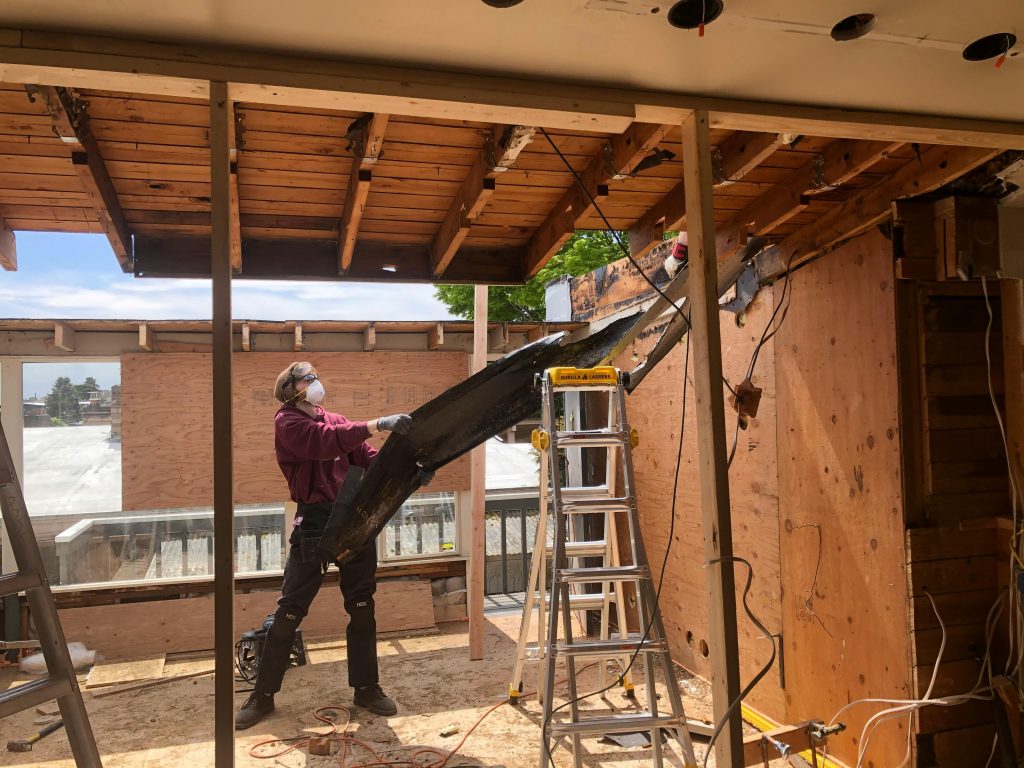
2.5 Contracts and Legal Requirements
- Written contract threshold. The Queensland Building and Construction Commission (QBCC) states that any domestic building work costing over $3,300, including labour, materials and GST, must be covered by a written contract. For projects over $20,000, the contractor must provide a copy of the QBCC consumer building guide before the owner signs. The contract must be in writing, signed and dated by both parties and comply with schedule 1B of the QBCC Act.
- Contents of the contract. A regulated contract should define scope of work, materials, cost, progress payment schedule, start and finish dates, dispute resolution procedures and any provisional sums or prime cost items. The QBCC provides templates for new homes and level 1 and 2 renovation contracts. Reviewing contract documents with a solicitor can prevent misunderstandings later.
- Insurance and warranties. Builders must hold appropriate licenses and provide home warranty insurance where applicable. In Queensland, owner builders cannot access the Home Warranty Scheme. For other states, check local legislation. You should also notify your home insurer about the extension, as coverage may need adjusting.
3 Approvals, Permits and Regulations
Australia’s building regulations involve multiple layers: federal standards under the National Construction Code, state legislation (e.g., the Planning Act 2016 in Queensland) and local council planning schemes. Understanding the process prevents costly delays and ensures your extension is legal and safe.
3.1 Building Approval (Building Permit)
A building permit (often called building approval) confirms that proposed construction complies with the NCC and other relevant legislation. Most types of building works require a building permit. This includes extensions or modifications, swimming pools, patios, carports, retaining walls over 1 m high, sheds and even shade sails. Building permits are issued by private building certifiers rather than councils. The certifier checks structural design, energy efficiency, fire safety and other NCC requirements; they also perform inspections at stages specified in the development approval.
In cyclone‑prone areas like Townsville, permits may require higher construction standards and materials. Even structures that might be exempt elsewhere, such as small sheds, could need approval due to regional conditions.
3.2 Planning Approval (Development Application)
While building permits deal with technical compliance, planning approval assesses how the development fits within local planning schemes, zoning and overlays. In Brisbane, if your extension does not meet all acceptable outcomes of the dwelling‑house code or the small‑lot code, you must lodge a development application. Planning approval may be needed when:
- The extension changes the building footprint or intrudes into setbacks;
- It adds a second storey or granny flat;
- The property is in a character or heritage overlay;
- The site lies within flood, landslide, coastal environment or other overlays;
- The extension affects neighbours’ privacy or street appearance.
Minor internal works often do not require planning approval. To determine whether your project is accepted development, code assessable or impact assessable, check the relevant City Plan or talk to council planners.
3.3 Other Approvals and Permits
- Referral agency response (siting relaxation). If your project does not meet all acceptable solutions of the Queensland Development Code—such as boundary setbacks—you may need to request a referral agency response from council through your certifier. Townsville City Council notes that if a structure does not comply with the QDC, a referral agency response is required before the building permit can be issued.
- Plumbing approval. Capping or altering sanitary drains requires plumbing approval and work must be performed by a licensed plumber.
- Heritage and character approval. Extensions to houses built before 1946 in Brisbane’s traditional character areas generally need planning approval. Similar heritage rules apply in other jurisdictions.
- Footpath permit. Where construction involves crossing or storing materials on footpaths, you may need a footpath permit.
- Owner‑builder permit. As described earlier, if you undertake a project over $11,000 without engaging a licensed builder in Queensland, you need an owner‑builder permit. Other states have similar schemes.
3.4 Navigating Council Processes
- Check property information. Use online tools such as Brisbane’s City Plan Online to confirm zoning and overlays. In Townsville, review the City Plan and supporting information pages.
- Consult professionals. A building designer or town planner can determine whether the extension is exempt or requires planning approval and can prepare documents for lodgement.
- Prepare documentation. For planning applications, you may need site plans, floor plans, elevations, shadow diagrams, engineering reports and a planning report addressing relevant codes.
- Lodge the application. Council will review the application, check that it is properly made and request payment of fees. Public notification may be required for impact assessable projects.
- Monitor progress. Track your application through council’s online portals (e.g., Development.i in Brisbane). Respond promptly to any requests for additional information.
4 Design Considerations
4.1 Blending Old and New
A successful ground‑floor extension harmonises with the existing home. Designers advise matching roof pitch, materials, window proportions and colour schemes to create a seamless appearance and enhance resale value. Where contrast is desired (e.g., using modern glass and steel against a traditional brick house), ensure that the new element intentionally complements the old rather than appearing tacked on.
4.2 Spatial Planning and Flow
- Open‑plan living. Rear extensions often remove internal walls to create a unified kitchen–dining–living space that opens to the garden. Structural beams may be required to replace load‑bearing walls.
- Zoning. Separate public and private areas. Place bedrooms away from noisy living areas and provide acoustic separation where possible. Consider including a powder room near living areas.
- Natural light and ventilation. Incorporate large windows, clerestory glazing and skylights. Orient windows to capture winter sun and prevailing breezes. Provide cross‑ventilation by aligning openings on opposite sides of rooms.
- Connection to outdoors. Use bi‑fold or sliding doors to link the extension to patios or decks. Decks can be covered with pergolas for shade.
4.3 Orientation and Passive Design
Australia spans eight climate zones with varying needs for heating, cooling and moisture control. While specific guidance for each zone is beyond this guide, some universal principles include:
- Orient living areas to the north (in the southern hemisphere) to maximise winter sun and minimise summer heat. Provide shading such as eaves, awnings or deciduous planting on the north and west.
- Use thermal mass (e.g., concrete slabs or brick walls) where appropriate to absorb and release heat slowly. In tropical zones, lightweight construction may be preferable to allow rapid cooling.
- Insulate roofs, walls and floors to reduce heat transfer. Use high‑performance glazing or double‑glazed windows.
- Seal gaps and provide controlled ventilation to maintain good indoor air quality without drafts.
4.4 Materials and Finishes
Material selection influences cost, maintenance and sustainability.
- Timber frame vs. brick. Timber frames are cheaper and quick to erect, but may require more maintenance. Brick veneer offers durability and better thermal mass but costs more; double‑brick is the most expensive option.
- Cladding. Options include brick, render, weatherboard, fiber‑cement panels or metal. Choose finishes that complement the existing house.
- Roofing. Consider whether to extend the existing roof or create a contrasting flat roof. Match roof materials for consistency.
- Flooring. Polished concrete offers durability and thermal mass; timber floors provide warmth. Ensure floor levels align between old and new spaces.
- Finishes. Select paints, tiles and fixtures that tie old and new spaces together. Wet areas require waterproof membranes.
4.5 Accessibility and Universal Design
Future‑proof your home by incorporating universal design principles:
- Level thresholds and minimal steps;
- Wider doorways (820 mm minimum) and hallways to accommodate wheelchairs;
- Reinforcement in walls to allow later installation of grab rails;
- At least one accessible bathroom on the ground floor;
- Adequate lighting and contrasting surfaces.
4.6 Sustainability
Sustainable extensions reduce energy use and improve comfort. Strategies include:
- Installing energy‑efficient windows and doors;
- Using high‑R‑value insulation and thermal breaks;
- Choosing low‑VOC paints and finishes;
- Integrating rainwater tanks for garden or toilet use;
- Fitting rooftop solar panels when adding roof space;
- Planning for future battery or electric‑vehicle charging.
Although specific Australian government sources could not be accessed via our browser due to dynamic content, these principles reflect standard sustainable design practice.
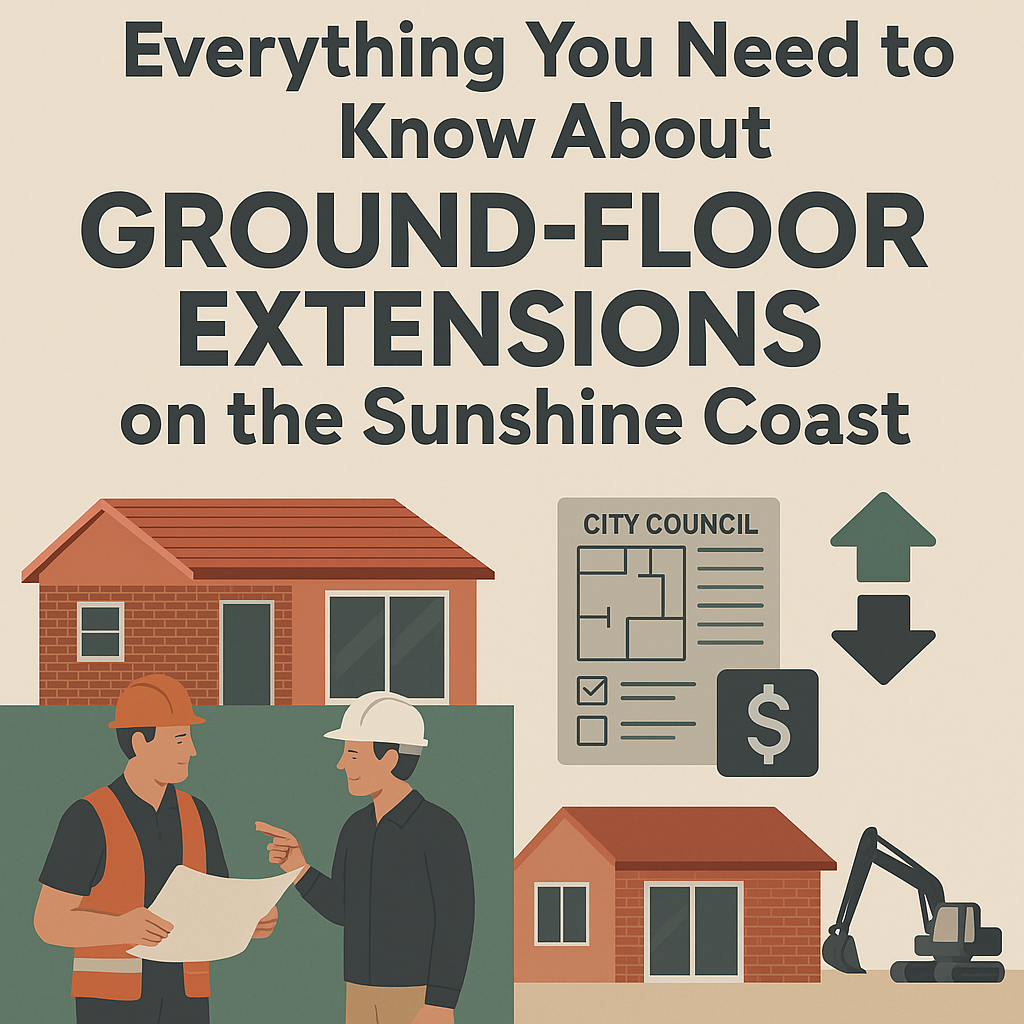
5 The Building Process
5.1 Concept and Design (2 – 8 weeks)
Work with a designer to prepare concept sketches, refine floor plans and select materials. The design should align with your brief, site conditions and budget. For complex projects, 3D modelling or virtual reality may help visualise the space.
5.2 Planning and Approval (2 – 8 weeks)
Simultaneously, consultants prepare documentation for planning and building approvals. Submissions may include architectural drawings, engineering reports, energy‑efficiency assessments and planning reports. Allow time for council assessments, neighbour notification and potential requests for additional information. In some states, a Complying Development Certificate (CDC) allows certain extensions to bypass full development approval if they meet prescriptive standards.
5.3 Pre‑Construction Setup (1 – 2 weeks)
After approvals, the builder orders materials, organises trades and sets up site facilities. They may establish temporary fencing, portable toilets and site storage. A pre‑start meeting reviews the contract, schedule and any final selections.
5.4 Construction (8 – 16 weeks)
The construction phase covers:
- Demolition and site preparation. Removing walls, clearing vegetation, levelling ground and installing temporary supports.
- Footings and slab. Excavate for footings or install piers. Pour concrete slab or construct a framed floor. In flood‑prone areas, raised floors may be required.
- Framing and structural work. Construct walls, install beams to support roof or upper floors, and build the roof. Structural steel may be necessary where large openings replace load‑bearing walls.
- Services rough‑in. Plumbers, electricians and HVAC technicians run pipes, ducts and cables through walls and floors before cladding.
- External cladding and roofing. Install cladding, windows, doors and roofing materials. Ensure flashing and waterproofing are correctly integrated.
- Internal linings and fit‑out. Fix plasterboard, waterproof wet areas, lay flooring, install cabinetry and fixtures. Connect plumbing and electrical to appliances.
5.5 Inspections and Handover
Building certifiers inspect the work at designated stages, such as footings, slab, framing, waterproofing and final completion. On completion, the builder provides a certificate of practical completion, warranty documents and manuals. A defects liability period allows you to report any issues that require rectification. Maintain records of approvals, contracts and warranties for future reference.
6 Managing the Project
6.1 Communication and Coordination
Effective communication is the cornerstone of a successful extension. The builder should provide a clear project roadmap with milestones and regular updates. Professional builders like Ward Builders emphasise transparent communication, with clients “part of the team and in the loop every step of the way”. Establish a single point of contact and maintain weekly meetings or email summaries. Document any changes or variations in writing.
6.2 Neighbour Relations
Keeping neighbours informed reduces disputes and, in some jurisdictions, is legally required. In New South Wales, neighbours within 20 metres must be notified 14 days before issuing a complying development certificate for some projects. Even when not mandated, letting neighbours know about your project timeline, potential noise and traffic demonstrates courtesy. Address any concerns promptly.
6.3 Dealing With Variations
Unforeseen issues—such as hidden structural defects, asbestos or design changes—may require variations to the contract. Variations should be documented, costed and signed by both parties. The QBCC provides variation forms with their contract packs. Keep a contingency fund to cover these costs.
6.4 Legal Disputes and Resolution
Despite careful planning, disputes can arise over quality, delays or payments. The QBCC and equivalent bodies in other states offer dispute resolution services. Contracts typically stipulate a process, starting with written notice to the builder, negotiation and, if unresolved, mediation or tribunal proceedings. Maintaining a detailed paper trail of communications, variations and payments is essential.
7 Costs and Budget Management
7.1 Cost Breakdown
Major cost components include:
- Construction: labour and materials for foundation, framing, roofing, cladding, plumbing, electrical and finishes. This accounts for the bulk of the budget.
- Professional fees: architectural and design fees (6 – 12 % of construction cost); structural engineering; land survey and soil testing; certifier fees.
- Approvals: council application fees, infrastructure charges and building certifier fees.
- Fit‑out: cabinetry, appliances, flooring, paint, lighting and fixtures.
- Contingency: 10 – 20 % buffer.
7.2 Factors Affecting Cost
- Site access and complexity. Sloping blocks, restricted access or tight urban sites increase excavation and delivery costs.
- Structural modifications. Removing load‑bearing walls or adding large openings requires steel beams and additional engineering.
- Quality of finishes. High‑end flooring, cladding, joinery and paint will increase the price.
- Roof integration. Matching complex rooflines or tying into existing roofs can be challenging.
- Plumbing and electrical extensions. Extending services adds cost, particularly when wet areas are added.
7.3 Budget Control Tips
- Obtain detailed quotes. Itemised quotes allow comparison and reduce ambiguity. Do not accept vague allowances.
- Include provisional sums and prime cost items. Identify items with uncertain costs (e.g., tiles) so you can adjust choices to stay on budget.
- Track progress payments. Ensure payments align with work completed. The QBCC contract templates provide progress claim forms.
- Beware of scope creep. Extra items—such as landscaping or furniture—can blow budgets. Factor them in upfront.
- Prepare for delays. Weather, supply chain issues and subcontractor availability can extend timelines, increasing costs. Build flexibility into your schedule.
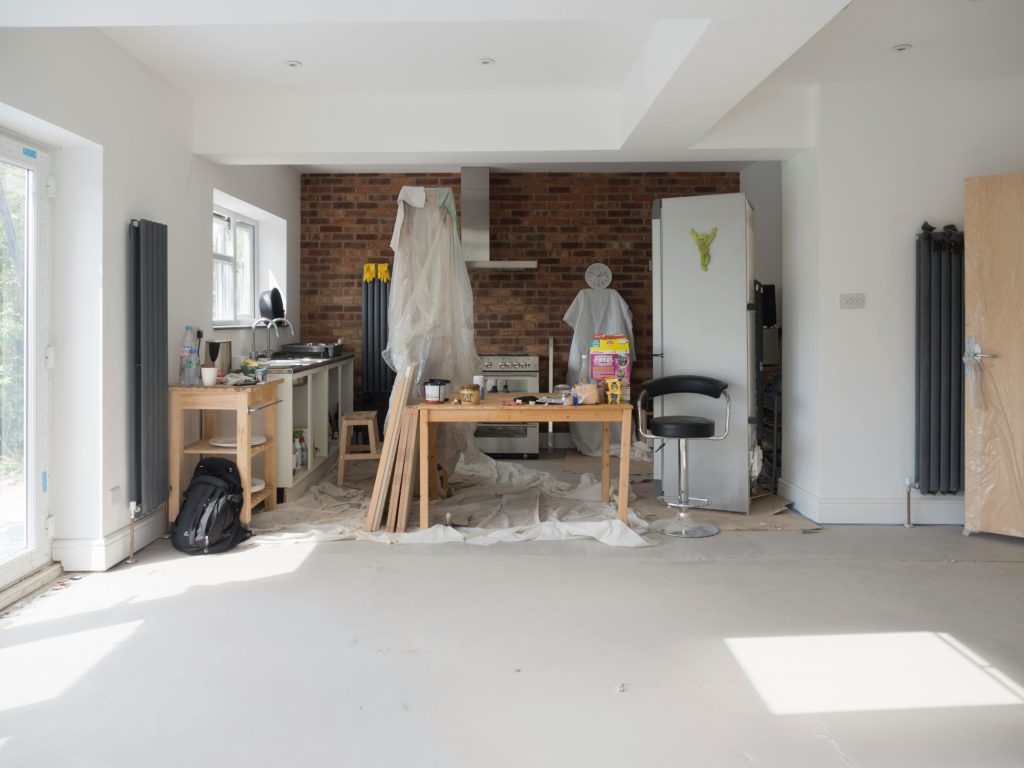
9 Hiring a Builder vs. DIY
9.1 Benefits of Professional Builders
- Expertise and quality. Professional builders understand the National Construction Code, local planning laws and best construction practices. Ward Builders, for example, have over 20 years’ experience on the Sunshine Coast and emphasise uncompromised quality and lasting craftsmanship. Their team plans each stage carefully to keep projects within schedule and budget.
- Project management. Builders coordinate trades, order materials and manage timelines, freeing you to focus on design decisions. A dedicated project manager can guide you through the process.
- Insurance and warranties. Licensed builders provide warranties and home warranty insurance (where required). Owner builders cannot access the Queensland Home Warranty Scheme.
- Reduced risk. Builders are familiar with council approvals and inspections, reducing the likelihood of non‑compliance. They also carry liability insurance.
9.2 Considerations for Owner Builders
Taking on an extension yourself offers potential cost savings but comes with challenges:
- You must obtain an owner‑builder permit for projects over $11,000.
- You cannot perform regulated trades like plumbing or asbestos removal without appropriate licences.
- You assume responsibility for safety, coordination of trades and compliance with the NCC.
- You can only obtain one permit every six years and there is no warranty insurance.
Most homeowners choose professional builders for peace of mind and quality outcomes.
10. Ground Floor Extension Builders to Consider
FEATURED: Ward Builders: The Go‑To Provider for Extensions
Ward Builders, based on the Sunshine Coast of Queensland, have established themselves as a leading provider of custom homes, extensions and renovations. They have been building “stunning transformations” for 20 years and emphasise a client‑centric approach with transparent communication.

Services and Approach
- Extensions and alterations. Ward Builders specialise in customised home alterations and extensions, offering guidance and creative ideas tailored to complement your existing home. They consider structural integrity, architecture, site features and your goals to ensure a well‑balanced outcome.
- Custom homes and renovations. Beyond extensions, they build new homes and undertake apartment renovations. Their portfolio includes luxurious penthouse transformations and large waterfront projects.
- Process. Each stage is carefully planned and executed with strict quality controls to keep projects on schedule and on budget. Clients are empowered through transparent communications and clear roadmaps.
- Design collaboration. Ward Builders collaborate with preferred design partners or your own architect to bring your vision to life. They offer creative ideas while respecting existing structures.
Project Examples:
https://wardbuilders.com.au/building-projects/
Client Testimonials
Customers praise Ward Builders for integrity, professionalism and attention to detail. One client noted that the team “worked with us every step of the way… [and] kept me up to date and came up with practical solutions”. Designer Briana Forster commended their communication and craftsmanship, noting that Ward Builders’ collaborative approach makes the process “easy” and produces high‑quality results. Such feedback underscores their reputation for reliability and quality.
Why Ward Builders Stand Out
- Dynamic team: The company describes its team as energised and collaborative.
- Great communicators: Clients are kept in the loop at every step.
- Honesty and reliability: They under‑promise and over‑deliver, avoiding shortcuts.
- Five‑star rating: Their commitment to craftsmanship and service is recognised by clients, designers and architects.
- Licensed and insured: Ward Builders hold a QBCC licence (1272680) and provide transparent costings and schedules.
Their website: https://wardbuilders.com.au/
Other builders:
Coastal Building & Extensions
With over 40 years in the industry, Coastal Building & Extensions specializes in home extensions and renovations across the Sunshine Coast. Their licensed team delivers exceptional craftsmanship, timely completion, and dependable service that homeowners trust for adding rooms, enhancing spaces, or expanding homes.
Website: coastalbuildingextensions.com.au
Oceanside Projects
Oceanside Projects is a Sunshine Coast‑based, licensed builder and member of Master Builders QLD and HIA, delivering custom home builds, renovations, and extensions. They are known for their high‑quality workmanship, client‑focused communication, and sourcing only trusted materials to achieve great results tailored to any budget.
Website: oceansideprojects.com.au
Dexterity Constructions
Dexterity Constructions positions itself as one of the leading house extension specialists on the Sunshine Coast, guiding clients from council approvals to build completion. They can create ground‑floor extensions, decks, second‑storey additions, or lift-and-build‑under projects—designed for maximum value, minimal disruption, and high attention to detail.
Website: dcbuilding.com.au
SG Builder
SG Builder brings a uniquely personalized approach to home extensions, aiming to evolve living spaces alongside lifestyle changes. They emphasize transparent communication, top‑quality materials, and impeccable craftsmanship—with every detail, from hidden storage to luxurious finishes, treated as an upgrade rather than just an addition.
Website: sgbuilder.au
Sources
https://www.tudorbuilding.com.au/blog/ground-vs-first-floor-additions-guide
https://www.openagent.com.au/blog/home-extensions-101-what-you-need-to-know
https://www.qbcc.qld.gov.au/home-owner-hub/owner-build/about-owner-building
https://www.openagent.com.au/blog/home-extensions-101-what-you-need-to-know








